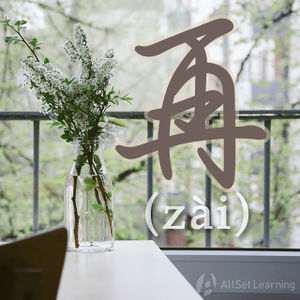Difference between revisions of "Sequencing with "xian" and "zai""
| Line 65: | Line 65: | ||
{{Basic Grammar|先|B1|先… 再…|<em>先</em> 洗 手,<em>再</em> 吃饭。|grammar point|ASGLJM55}} | {{Basic Grammar|先|B1|先… 再…|<em>先</em> 洗 手,<em>再</em> 吃饭。|grammar point|ASGLJM55}} | ||
{{Rel char|再}} | {{Rel char|再}} | ||
| + | {{Rel char|然后}} | ||
{{Similar|"Never again" with "zai ye bu"}} | {{Similar|"Never again" with "zai ye bu"}} | ||
{{Similar|Again in the future with "zai"}} | {{Similar|Again in the future with "zai"}} | ||
Revision as of 01:56, 16 July 2013
-
Level
-
Similar to
-
Used for
-
Keywords
The word 再 (zài) actually has a lot of uses, beyond just "again." "先..., 再..." (xiān..., zài...) is a pattern used for sequencing events, much like "First..., then..." in English. This pattern can also include "然后" (ránhòu) meaning "and after that."
Contents
General Usage of 先……再……
In the pattern below, 再 has a meaning of "then" or "and then."
Structure
先 + [Event 1] + 再 + [Event 2]
Examples
- 我 会 先 洗 手,再 吃 晚饭。First, I'm going to wash my hands, then I'll eat.
- 她 要 先 吃 早饭,再 去 学校。First, she's going to eat breakfast, then she'll go to school.
- 他 的 朋友 都 先 看 电影,再 去 酒吧。His friends all went to watch a movie first, then they went to the bar.
Using 再说
You may have learned that "再说" can mean "in addition." Well, this usage of 再 is a more literal combination of 再 + 说, fitting into the 先……再…… pattern.
So in this usage, 再说 doesn't really mean "in addition." Rather, it most literally means "and then we'll talk." In other words, "let's just do this now," and then after we see the result, we can talk some more about next steps. There's kind of a "let's see how this goes first" feeling to the expression.
Structure
Note that in the pattern below, the sentence normally ends with 再说.
先 + [Event 1] + 再说
Examples
- 先 吃饭 再说 。Let's eat first, then we'll talk.
- 先 做 完 这个 再说 。First finish this, then we'll talk.
- 我 先 上 个 厕所 再说 。I'm going to go to the bathroom first, then we can talk.
- 我们 先 休息 一下 再说 。Let's rest a little first, then talk.
- 你们 先 讨论 一下 再说 。You guys discuss a little first, then we'll talk.
Sources and further reading
Books
- Integrated Chinese: Level 1, Part 1 (3rd ed) (pp. 258-9) →buy
- Integrated Chinese: Level 2, Part 2 (pp. 19-20) →buy
- 卓越汉语-公司实战篇 (p. 172) →buy



